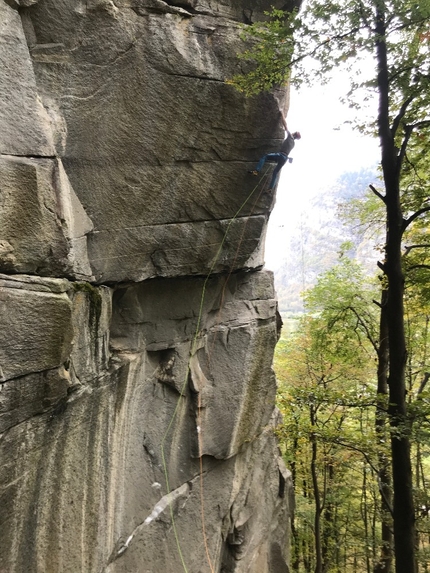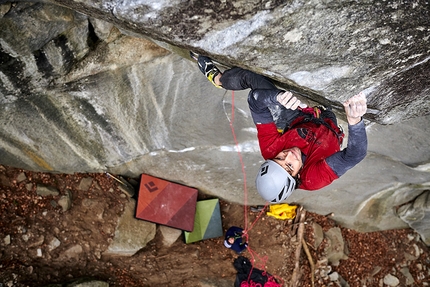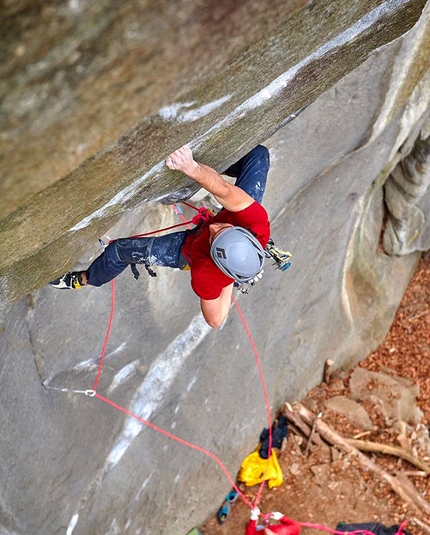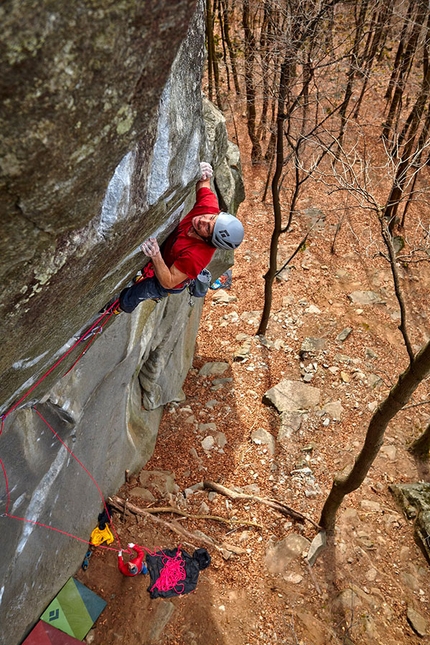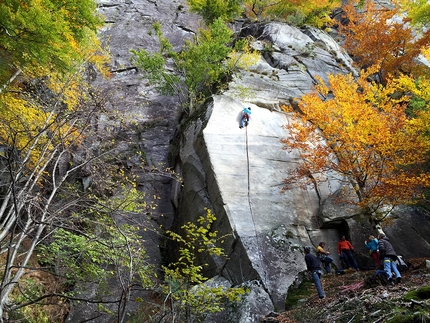Tribe at Cadarese: the James Pearson second ascent interview
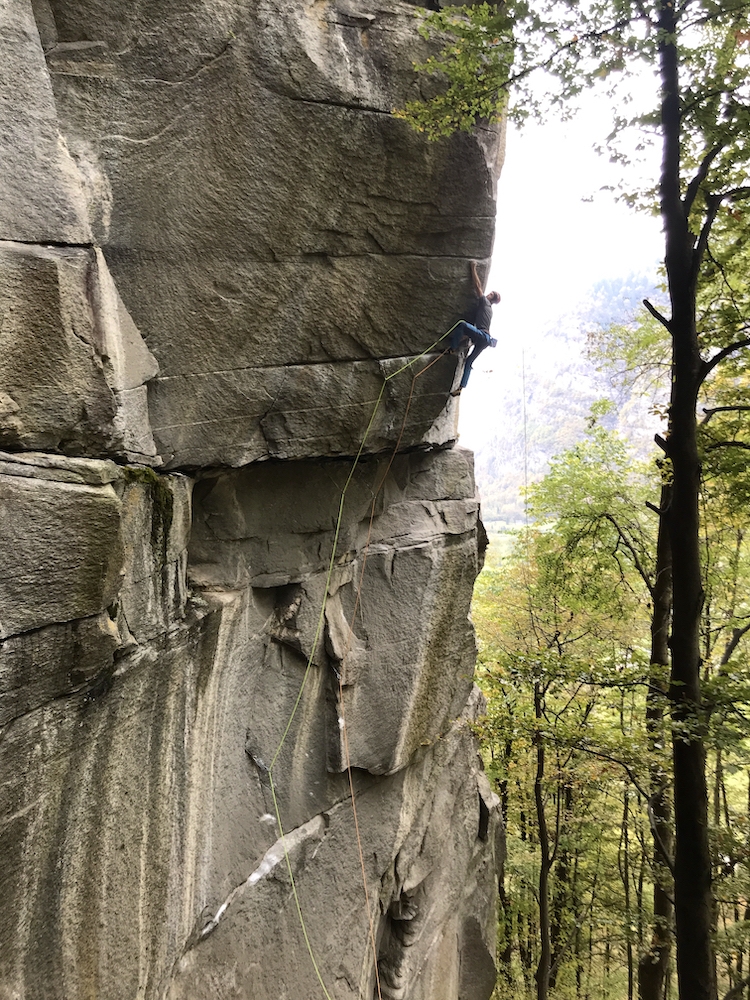
 1 / 4
1 / 4 Caroline Ciavaldini
Caroline Ciavaldini
Last week England’s James Pearson made the second ascent of Tribe which, although ungraded, is reputed to be one of the hardest trad climbs in the world. Located at Cadarese in Northern Italy, the 30m line was first ascended in early 2019 by Jacopo Larcher after a 6-year courtship, while 34-year-old Pearson made a remarkably fast repeat on the 21st of October 2020, on the last day of his short trip before returning home to France.
James tell us about Tribe
Well anyone who’s into trad climbing knows about Tribe. I’ve climbed at Cadarese a lot in the past 10 to 15 years and every time I came here I looked at the route, even before Jacopo started trying it. It’s such an obvious line, I even thought that I’d like to try it myself one day but I never did. Perhaps because deep down I thought it was impossible. Then when our baby Arthur was born everything was put on hold, and it’s taken me a while to find my form again and commit to something as big and important as Tribe.
You came here specifically with this route in mind
Yes. I thought it would be a long-term project and at first Caroline and I planned on staying here for three weeks. I know from experience that the weather here can be fickle and finding good conditions can be difficult, that’s why we planned this first longish trip. The idea was just see if I could do all the moves, then maybe come back a few months later to send it, but actually it went down pretty quickly, which was very definitely a welcome surprise! Never in a million years did I think I’d get to do it on this trip!
How did it start?
Well in the beginning I didn’t actually do any climbing at all, instead I cleaned the upper levels that were wet and covered in moss. It was basically a dirty waterfall. When it finally dried out I fixed a static rope and started deciphering the moves. Then two Saturdays ago I was joined by Jernej Kruder, he’d written to ask if we could work the route together. I wasn’t really sure what to think at first because I’ve never tried a hard route with anyone else before and I was worried it might become awkward or overly competitive, but actually it was perfect. We worked really well together, exchanging methods, psyching each other up to give our very best.
Jacopo told us about the route in detail after his first ascent. What can you tell us about your efforts?
First of all I used exactly the same beta as Jacopo, except perhaps for some footholds on the 1st boulder crux which for me was a bit easier because I’m a bit taller - you really have to stretch out to a bad pinch and my feet were on better holds. On the top boulder crux Jernej does a big dyno to the top, whereas I did it just like Jacopo: powerful, technical and delicate moves. Although I couldn’t do the sequences every time I decided to jump on the lead almost immediately to get a better feel for the overall difficulties and on my first go I fell getting into the second boulder problem, which was encouraging. My second go went even better. It was the end of the day, conditions were greasy, I felt tired and since I was under no pressure at all I got to the penultimate move. It was then that I realised that it might not be a long-term project after all.
How did things progress?
Actually they didn’t. On my third day I fell a lot lower down, and begun to get worried so I took a rest day on Monday. On Tuesday I fell off the pinch move at the first boulder and was concerned I’d get stuck in a rut. At midday I gave it another go and fell after the pinch. I was beginning to feel the pressure and was worried I’d run out of time and luck. I gave it one more try at the end of the day, more a sort of training go than anything else and reached my previous highpoint. So I was back in the game, but the weather forecast was bad and lockdown might be imminent.
That was last Tuesday
We returned on Wednesday morning, it was meant to rain later that day and we were leaving that evening. Conditions felt OK though and I thought I’d give it one last chance. Caro has been teaching me a lot about the benefits of visualisation and I’d kept imagining reaching the top jug. When I set off I climbed in auto-pilot mode, stuck the pinch, and then all of a sudden I reached that top jug. I’d visualised it so much I didn’t even scream for joy, it was only when I heard Jernej whooping from down below that I realised I’d actually done it! Luckily I held it together and made it up the 7b finger crack to the top. Compared to the rest this last section isn’t hard, but you could still fall off and you definitely wouldn’t want to do that!
You amazed perhaps yourself most with your repeat. Despite your trad climbing pedigree…
I’m totally honest: the ascent was completely unexpected. I’m in good shape having climbed 9a in summer, but in many ways this route is better suited to a top boulderer than a sports climber. Yes, it’s a trad climb and not a bolted sport climb, but on the whole the route is quite safe. Sure, there are some sections where you shouldn’t fall, but they’re relatively easy. If you know how to place gear, and you’re confident falling on it, then this is a great route.
What about its difficulty?
Well as you know I’m not the best at assigning grades, I’ve got a history of grading controversy and I tend to steer away from giving numbers. Having said that, in my experience Tribe has got the hardest series of moves I’ve ever done on a trad route. You’re looking at a Font 7C/8A boulder problem followed by a pretty good rest and then another Font 8A/8B crux. That’s a huge step up in terms of difficulty compared to anything I’ve ever done before, incuding my Le Voyage at Annot. The sequences are so intense, and the holds are so poor, yet somehow it all works, and perfectly at that! And the great thing is that it’s all on gear! The holds open up just enough exactly where you need them to place the good gear, then shut down to make the climbing a bit runout and spicy
By the sounds of things it’s a great route
Very definitely. I’d love to see other people try it. Not because it’s maybe the world’s hardest trad route, but because it’s so beautiful and fun to climb. There isn’t a single hold that is painful, which isn’t often the case on cutting-edge routes, and it’s also pretty easy to work and strip. It’s overhanging enough to take clean falls, and not too overhanging to make removing the gear complicated. People should try it for the pure pleasure of trying an ace route.
That’s quite something
I’d like to celebrate Jacopo’s incredible vision for Tribe. I’ve got massive respect for what he did. Year after year he went back to try it, not knowing if it was possible. Realistically, had it not been for him, the route would still be a project. Had he not abseiled down it, cleaned it and believed it was possible, people would still be walking past it like I did without realising it’s such a gem.
You mentioned your young son Arthur. In the past you’ve done some really dangerous trad where you’ve even risked your life. Have things changed now that you’re a father?
Well I can’t rule out that I’ll never do anything dangerous again, but my relationship with danger has certainly changed considerably. I did my most risky climbs when I was 18 or 19, when you think you’re superhuman and nothing can stop you. It’s only when growing up do you fully comprehend the consequences of failure, and that gravity can very, very efficient. I think I’ll have to assess each situation as it comes and weigh up the pros and cons. Just as I did with Tribe: difficult but safe. And such a great route!
With La Sportiva



 Copia link
Copia link

